�
�
SULTANS OF SWAP:
BP Potentially More Devastating than Lehman!
��
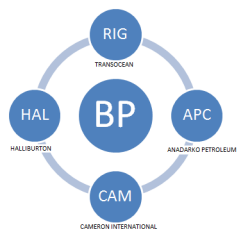 As
horrific as the gulf environmental catastrophe is, an even more
intractable and cataclysmic disaster may be looming. The yet unknowable
costs associated with clean-up, litigation and compensation damages due
to arguably the world�s worst environmental tragedy, may be in the
process of triggering a credit event by British Petroleum (BP) that will
be equally devastating to global over-the-counter (OTC) derivatives. The
potential contagion may eventually show that Lehman Bros. and Bear
Stearns were simply early warning signals of the devastation lurking and
continuing to grow unchecked in the $615T OTC Derivatives market.
As
horrific as the gulf environmental catastrophe is, an even more
intractable and cataclysmic disaster may be looming. The yet unknowable
costs associated with clean-up, litigation and compensation damages due
to arguably the world�s worst environmental tragedy, may be in the
process of triggering a credit event by British Petroleum (BP) that will
be equally devastating to global over-the-counter (OTC) derivatives. The
potential contagion may eventually show that Lehman Bros. and Bear
Stearns were simply early warning signals of the devastation lurking and
continuing to grow unchecked in the $615T OTC Derivatives market.
�
What is yet unknowable is what the reality is of BP�s off-balance sheet
obligations and leverage positions. How many Special Purpose Entities
(SPEs) is it operating? Remember, during the Enron debacle Andrew Fastow,
the Enron CFO, asserted in testimony nearly 10 years ago that GE had
2500 such entities already in existence. BP has even more physical
assets than Enron and GE. Furthermore, no one knows the true size of
BP�s OTC derivative contracts such as Interest Rate Swaps and Currency
Swaps. Only the major international banks have visibility to what the
collateral obligations associated with these instruments are, their
credit trigger events and who the counter parties are. They are
obviously not talking, but as I will explain, they are aggressively
repositioning trillions of dollars in global currency, swap, derivative,
options, debt and equity portfolios.
�
Once again, as we saw with Lehman Bros and Bear Stearns we have no
visibility to the murky world of off balance sheet, off shore and
unregulated OTC contracts, where BP�s financial risk is presently being
determined.� At a time when
understanding a corporation�s risk position is critically important,
investors are in the dark. When markets are uncertain, bad things are
certain to follow. �The new
financial regulations under the Dodd-Frank legislation does absolutely
nothing to address this. This was the central issue in truly
understanding and corralling TBTF risk. It has not been addressed and
the markets will likely make the tax payer pay for this regulatory
failure once again.
�
Massive BP Risk lay in the $615T OTC Market that only the major
international banks have any visibility to�. and they are not talking!
�
 �
�
�
THE LEVERAGE ASSOCIATED WITH �AAA� ASSETS
�
I could not have stated it any clearer than Jim Sinclair at
jsmineset.com: �People are seriously underestimating how much liquidity
in the global financial world is dependent on a solvent BP. BP extends
credit � through trading and finance. They extend the amounts, quality
and duration of credit a bank could only dream of. You should think
about the financial muscle behind a company with 100+ years of proven
oil and gas
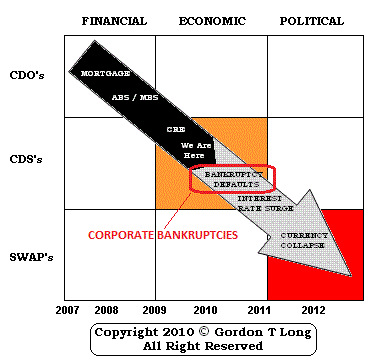 reserves.
Think about that in comparison to a bank with few tangible assets. Then
think about what happens if BP goes under. This is no bank. With proven
reserves and wells in the ground, equity in fields all over the planet,
in terms of credit quality and credit provision � nothing can match an
oil major. God only knows how many assets around the planet are
dependent on credit and finance extended from BP. It is likely to dwarf
any banking entity in multiples�. The price tag and resultant knock-on
effects of a BP failure could easily be equal to that of a Lehman, if
not more. It is surely, at the very least, Enron x10.�
reserves.
Think about that in comparison to a bank with few tangible assets. Then
think about what happens if BP goes under. This is no bank. With proven
reserves and wells in the ground, equity in fields all over the planet,
in terms of credit quality and credit provision � nothing can match an
oil major. God only knows how many assets around the planet are
dependent on credit and finance extended from BP. It is likely to dwarf
any banking entity in multiples�. The price tag and resultant knock-on
effects of a BP failure could easily be equal to that of a Lehman, if
not more. It is surely, at the very least, Enron x10.�
�
From a historical context, some may not be aware that the infamous House
of Rothschild at the height of their banking power
moved into Energy & Oil.�
Also, John D. Rockefeller
quickly realized his globally expanding Standard Oil was more
a bank, consolidating his financial empire under a banking structure
which resulted in the Chase Manhattan Bank (the basis of Citigroup). As
long as an energy giant can manage its cash flows throughout the
volatility of price fluctuations, it becomes a money and credit
generating machine. It can borrow with AAA yields anywhere on the curve
and lend to less credit worthy entities at attractive spreads. These
lending differentials help fuel the $430T Interest Rate Swap OTC market.
�BP has been able to spin off
$20B of earnings for the last 5 years and $15B in cash last year.
All of this suddenly comes to an end if its credit rating is
significantly impaired. But what could possibly cause this to happen? It
would take a black swan event. An outlier. A fat tail.
�
Sound familiar? Heard this discussion before?
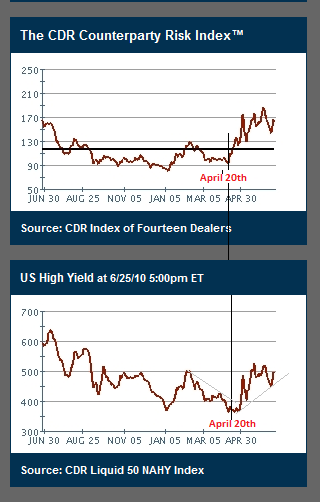 �
�
The Gulf Oil Disaster may be the fat tail to end all fat tails and shows
the exposure behind the entire risk models of the vast majority of
derivatives algorithm models. To suggest that BP would need to take
impairments north of $20B would have seemed out of the realm of
possibilities less than 90 days ago. Now, if it is contained to only
$20B, it would be considered a blessing.
Fitch dropped BP�s credit rating an unprecedented 6 notches on
June 15th from AA to BBB
which followed June 3rd's AA+ to AA cut.�This is what
happens when a fat tail occurs and it has only just begun.
�
CONTAGION HAS BEGUN
�
Though few are talking openly, it doesn�t mean large amounts of money
aren�t aggressively repositioning.�
This repositioning is effectively de-leveraging and is
consequentially a liquidity drain. This comes as US M3 has gone negative
and M2, M1 are rapidly declining. �BP
is going to face a massive liquidity crunch which has all the earmarks
of triggering an already tenuous and worsening international liquidity
situation.
�
I found the charts (right) published
by Credit Derivatives Research to be very telling of the
abrupt shift that has occurred. Their charts show that the April 21st�
Macondo well explosion has triggered a significant inflection in
the risk, counterparty and high yield areas. A comparison with
Government and High Grade Debt has a different profile (see end of this
report for the charts) which reflects the European banking concerns
associated with the southern European economies (PIIGS). It is important
to differentiate these as separate drivers. Both come as the percentage
of corporate bonds considered in distress is at the highest in six
months - a sign investors expect the economy to slow and defaults to
rise. This spells deleveraging.
�
WHAT WE KNOW ABOUT BP DERIVATIVES:
�
1 - CSO (Credit Synthetic Obligations)
�
A study by
Moody�s outlines that a BP bankruptcy would impair 117
Collateralized Synthetic Obligations (CSOs), which would lead to
pervasive losses by a broad range of holders. The 117 effected is a
startling 18% of the total CSOs outstanding, which is an indication of
the scope and impact of BP financing globally. For those that remember
the 2008 financial debacle, you will recall its epicenter was the
collapse of Collateralized Debt Obligations (CDO)
�associated with mortgages and
Credit Default Swaps (CDS) of financial companies impacted. CSOs are
even more leveraged and toxic.

The exhibit above lists CSOs
(excluding CSOs backed by CSOs) with over 3% exposure
to the five companies involved in the Gulf of Mexico incident.
�
To quote
Moody�s:
�
In the event of BP�s restructuring or bankruptcy, CSO transactions
referencing BP or its affected subsidiaries may experience what is
called a �credit event.� If the credit event occurs, the CSO
transactions will have to meet their payment obligations to the
protection buyers, which will result in the loss of subordination to
the rated CSO tranches. In cases where the subordination is no
longer available, CSO investors will incur the loss.
�.
We reviewed our entire universe of outstanding CSOs and determined
that exposure to BP and its rated subsidiaries appears in 117
(excluding CSOs backed by CSOs) transactions, which represents
approximately 18% of global Moody�s-rated CSOs. Exposure ranged from
0.26% to 2% of the respective reference portfolios. The transaction
with the largest exposure to BP and its subsidiaries is Arosa
Funding Limited � Series 2005-5.
�
Restructuring or Bankruptcy of Other Oil Companies Involved in the
Spill Also Affects CSOs. In addition, we assessed Moody�s-rated CSO
exposure to the other four companies and their subsidiaries that
were involved in the Gulf of Mexico incident, which are Halliburton,
Anadarko Petroleum, Transocean Inc., and Cameron International.
Halliburton appears in 43 CSOs, Anadarko Petroleum appears in 28
CSOs, Transocean Inc. appears in 79 CSOs, and Cameron International
appears in 6 CSOs. We recently changed the credit outlooks for
Transocean and Anadarko Petroleum, as well as their rated
subsidiaries, to negative from stable because of uncertainties
related to the companies� involvement in the Gulf of Mexico incident
and potential financial liabilities associated with it. The CSOs
referencing one or more of these issuers would face credit event
consequences in a scenario where any of them restructures or enters
bankruptcy.
�
We need to recall that Transocean was the owner /operator of Deepwater
Horizon with 131 of the actual 137 employed by Transocean (RIG) and that
Anadarko (APC) was BP�s 25% partnership holder in the well. Cameron
International (CAM) was the builder of the faulty blowout preventer and
Halliburton (HAL) the contractor for the well cementing operation in
sealing the 13,350 foot Macondo drill site. These players will no doubt
be heavily involved in the litigation and compensation settlements, but
additionally will have collateral damage on other oil industry
participants as they are forced to raise cash for litigation and claims.
�
2 - CDS (Credit Default Swaps)
�
On June 25th BP�s Credit Default Swaps shot up 44 to 580 on
the 5 years CDS. This meant it costs $580,000 per year to ensure $10
million in BP bonds over a 5 year contract period.�
Anything approaching 300 is considered serious risk. For
counterparties willing to pay this amount means their dynamic hedging
models are working over time and a near panic scramble is taking place.
�
On June 16th Zero Hedge Reported:
�
The BP Curve has really flipped (out). The 1 year point on the curve is
now over 1,000 bps, a 400 bps move in one day. The point is also
offerless (bidless in traditional cash jargon). Granted the DV01 so
close to 0 is rather low, but this kind of ridiculous curve inversion is
simply wreaking havoc on correlation desks. The 6 month point is now 0.5
pts upfront. Pretty soon BP will need to apply for the same ECB bailout
that rescued all those banks who were risking a wipe out when Greek
spreads were trading at comparable levels. The question now becomes: who
sold the bulk of the BP protection? BofA's announcement yesterday
(06-15-10) that it is limiting counterparty risk exposure with BP to all
contracts over 1 year could be a rather material clue as to the identity
of at least one such entity.
3 - BOND INVERSION
�
With Credit Default Swap concerns we would expect this to be reflected
in BP�s Yield Curve Spread. What is interesting here is that the curve
is inverted as is BP�s CDS curve (shown above). Usually short term
yields are less than longer term yields because of inherent risk over a
longer period of time. For instance, one heavily traded bond, which
matures in March 2012, traded with 9.48% yield recently. Meanwhile,
further down the curve a bond that matures in March 2019 is trading at a
yield of 7.74%, less than the shorter-term bond. This suggests that the
market is pricing in a credit event. A credit event would have a
profound impact on OTC contracts, which we have no visibility to.
�
What we do know however is that BP has between $2 and $2.5 Billion in
one year commercial paper to rollover that is required for trading
operations and working capital.� �This
is going to make it both more expensive and harder to secure and will be
a liquidity drain for BP.
�
4 � LIQUIDTY REQUIREMENTS
�
To the above Commercial paper roll-over ($2-$2.5B in one year), ongoing
new and rollover debt issuance, we need to add the $20B it has agreed
with the White House to put in place, though we know of no detailed
agreement actually being signed.
��
5 - SHORT INTEREST
�
The Financial Times Alphaville via Data Explorers
reported the short interest through June 4th. As you can see from the graph below by stripping out the spike related
to the last dividend payment, the underlying level of stock outstanding
on loan (SOOL) has barely budged since the spill.�
So, short sellers can�t be blamed for the plunge; the selling
must be coming from somewhere else, such as long-only funds. Rumors
circulated 06/10/10 that Norges Bank was looking to offload 330m shares.�
Brokers said the total Transatlantic volume of stock traded in BP
06-09-10 had a value of $8bn. To put that figure into some perspective,
the total volume traded on the entire EuroStoxx index on the same day
amounted to $15bn.�
Moreover, since the Deepwater Horizon rig exploded on April 21st, 70 per
cent of BP�s market cap has turned over, most of it in the US. Trading
volumes in BP American Depository Receipts (ADRs) are usually 10 per
cent lower than the ordinary shares in London. Since the spill, that
position has been reversed and the ADRs have traded 3.5 times the
ordinaries, all of which suggests BP�s largest US investor base have
been dumping stock.
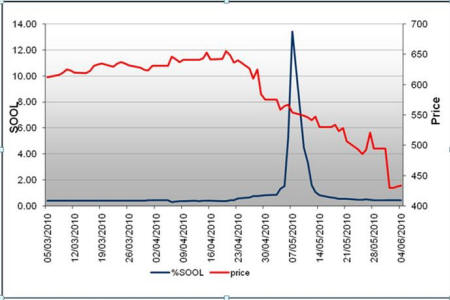
�
How long before equity shorting begins?
It must be noted here that this is BP equity. Shorting activity of BP
debt is all together another matter especially concerning dynamic
hedging, with again much less visibility.
�
6 - OPTIONS ACTIVITY
�
Wall Street Pit
on 06/10/10 wrote that
�Options volume on beleaguered oil company, BP PLC, is fast approaching
750,000 contracts, fueling a more than 79.7% upward shift in the stock�s
overall reading of options implied volatility to a 5-year high of
120.96%. Options activity on the stock can easily be described as
frenzied as volume continues to grow in both call and put options across
multiple expiries.�
�
COST OF CAPITAL IS SKYROCKETING FOR BP WHICH AS FUNDAMENTALLY AN ENERGY
FINANCING CORPORATION CAN BE TERMINAL!
SIZE & SCOPE OF LITIGATION
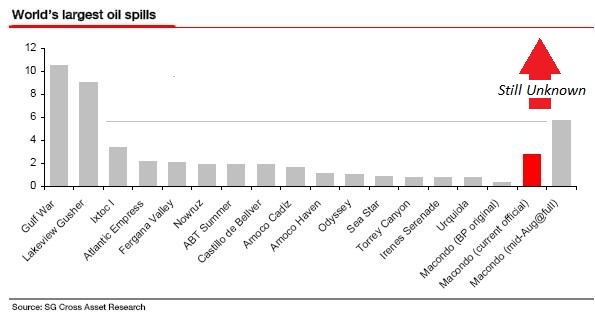
Are the final gulf oil spill costs going to be
$20B or $60B? Does anyone know? I personally believe it is closer to
the latter than the former. If we just use the reported oil spillage
numbers for comparison we might get a better understanding of the
complete failure to grasp the scope of the disaster.�
According to the Financial Times, the oil spillage
was reported
as follows:
�
�����������������������
SPILLAGE���������
� COST
������������
INCREASE
(bls./day)���������
TO DATE ���������
April 20������������
1000����
May 4���������������
5000����������������
May 7���������������
5000����������������
350M����
May 14�������������
5000����������������
625M
May 28�
���������
15,500���������������
950M
June 3��
���������
19,000���������������
990M
June 8��
���������
15,500���
���������
1,250M
June 10
���������
15,500���
���������
1,430M
June 17
���������
15,500���
���������
1,600M
June 23
���������
25,800���
���������
2,600M���������������
Spillage increased by 25 X in 60 days
�
As time passes the numbers are rising exponentially. Engineers
are warning
that the capture will be complicated and scientists monitoring the
situation are predicting the spill will prove larger than the current
estimates are reflecting. An expert in the field, Matt Simmons of
Simmons International has
stated
that the flows are over 100,000 barrels per day.�
Most independent experts agree.
�
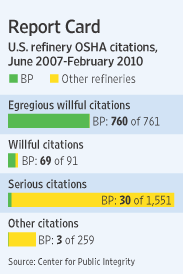 Assuming $4,000/barrel damages costs, 100,000 barrels per day flow
rates, a 90 day flow duration (minimal), we arrive at clean-up,
litigation and damage compensation of approximately $32B. This is nearly
twice the US escrow account agreement and within our expectations of
between $20 and 60B. There are a range of issues regarding further
leaks, shifting seafloor, methane levels, hurricanes, disbursement
effects and many more that are surfacing daily that will have
significant negative impact on current analysis and assumptions.
Assuming $4,000/barrel damages costs, 100,000 barrels per day flow
rates, a 90 day flow duration (minimal), we arrive at clean-up,
litigation and damage compensation of approximately $32B. This is nearly
twice the US escrow account agreement and within our expectations of
between $20 and 60B. There are a range of issues regarding further
leaks, shifting seafloor, methane levels, hurricanes, disbursement
effects and many more that are surfacing daily that will have
significant negative impact on current analysis and assumptions.
An
element of future litigation that is very concerning is the amount of
punitive damages that may be awarded. After the
White House sent
Attorney General
Eric Holder
to New Orleans to threaten BP with criminal prosecution,
BP responded that it believes a case of negligence can�t be proven.
However, the Deepwater Horizon travesty comes at a particularly bad time
for BP. �According to
Caroline Baum at Bloomberg:
�BP is already the most reviled company in America. Two of its
refineries accounted for 97 percent of the violations (a total of 862,
of which 760 were �egregious willful�) in the refining industry over the
last three years, according to the
Center for Public Integrity.
It holds the record for the
largest fine
($87 million) ever levied by the Occupational Safety and Health
Administration.� Additionally, the US Chemical Safety & Hazard
Investigation Board has immediately jumped into the oil spill
investigation as they did previously at the 2005 fire and explosion of
BP�s Texas City refinery that killed 15 and injured many others.
�
After Moody�s cut Anadarko�s rating to junk late on June 18th, the US
oil company (a 25 per cent non-operating investor in the Macondo well)
broke its eight-week silence with this
broadside
from CEO Jim Hackett:
�
�The mounting evidence clearly demonstrates that this tragedy was
preventable and the direct result of BP�s reckless decisions and
actions. Frankly, we are shocked by the publicly available information
that has been disclosed in recent investigations and during this week�s
testimony that, among other things, indicates BP operated unsafely and
failed to monitor and react to several critical warning signs during the
drilling of the Macondo well. BP�s behavior and actions
likely represent gross
negligence or willful misconduct and thus affect the obligations of
the parties under the operating agreement.�
�
We can safely surmise that the stab in the dark by the White House of
$20B is about as accurate as its forecasts of GDP growth, unemployment
improvement and the Recovery and Reinvestment Act of 2009. Slim to none.
A more realistic number is likely substantially larger and will likely
surface soon. However, anything larger than $20B is likely to be the
immediate nail in the coffin for BP as evidenced by how quickly the
newly elected British Prime Minister was dispatched to the White House
to stop the mounting implosion of both BP and the seriously impacted
British Pension system.
�
BP RESPONSE
�
BP has
stated
it has immediate cash available of $15B and will raise additional cash
via:
�
1-���
Asset Sales
2-���
Capital Expenditure Cuts
3-���
Dividend Cut for the Next 3 Quarters
�
LEHMAN BROS / BEAR STREARNS DEATH SPIRAL
�

�
To again quote Jim Sinclair at jsmineset.com: �BP is the primary player
on the long-end of the energy curve. How exposed are Goldman sub J.
Aron, Morgan Stanley and JPM? Probably hugely. Now credit has been cut
to BP. Counter-parties will not accept their name beyond one year in
duration. This is unheard of. A giant is on the ropes. If he falls, the
very earth may shake as he hits the ground.
�As we are beginning to see, the
Western pension structure, financial trading and global credit are all
inter-twined. BP is central to this, as a massive supplier of what many
believe(d) to be AAA credit. So while we see banks roll over and die,
and sovereign entities begin to falter� we now have a major oil company
on the verge of going under. Another leg of the global economic "chair"
is being viciously kicked out from under us.�
�
The whole BP travesty is quickly compounded via the OTC Derivatives
market and the risk inherent within it.
1-���
As it was in Lehman, opacity is once again experienced when transparency
is most critically required.
2-���
Finance has always been about risk determination but never before with
so much leverage associated with risk assessments and held in such
complex, dependent structured instruments.
3-���
Investors� are still
unprotected. The Frank-Dodd Bill is now nothing more than watered down
window dressing before it finally reaches legislative approval and even
before it begins the regulatory supervision machinations.
4-���
Investors hate uncertainty and we have nothing but uncertainty here:
a.����
Political
b.����
Legal
c.����
Financial
d.����
Business
�
CONCLUSIONS
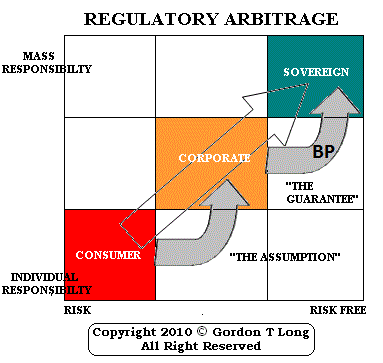
�
The most likely scenario is that the US operations of BP will
voluntarily attempt Chapter 11 bankruptcy proceedings. This is the worst
possible scenario for claimants. The problem here is that this triggers
a credit event which has daunting repercussions to the highly leveraged
global financial markets. Like AIG before, the government does not want
to tamper with the ramifications and fall out of a CDS event. Lehman was
one too many.
�
If a US voluntary bankruptcy is stopped by the US and there is a BP
corporate �bankruptcy, then there
is a strong possibility that the British Government will be forced to
step in and bailout BP.� In
the end, the tax payer will pay as the ongoing game of Regulatory
Arbitrage is played masterfully once again.
�
Deleveraging associated with BP may be the event that triggers the $5T
Quantitative Easing spike we have been warning about for some time now.
It will be needed to complete the final process of manufacturing of a
Minsky Melt-up to avoid the looming pension, entitlement and US state
financial crisis.
�
The ability of the government to achieve this is anything but certain.
However, we need to expect the unexpected
and
watch out for fat tails we might trip over.
�
�

The Dodd-Frank Legislation leaves investors & taxpayers once again
exposed to another Lehman
The Regulatory Arbitrage Game Continues.
�

�
SOURCES:
(1)��
06-21-10
BP's Bankruptcy Would Impair 117 (18% Of Total) Collateralized Synthetic
Obligations, Lead To Pervasive Losses�
Zero Hedge
(2)��
06-16-10
BP CDS Curve Goes Nuts, 1 Year Passes 1,000 Bps, No Offers In Market�
�Zero Hedge
(3)��
06-25-10
BP Getting Crushed: What Does its �Yield Inversion� Mean?��
WSJ
(4)��
06-28-20
Interactive timeline: BP oil spill disaster
�Financial Times
(6)��
06-25-10
BP reassures on cash pile as shares plunge
Financial Times
(7)��
06-18-10
Macondo, in historical Hollywood context�
FT Alphaville
(8)��
06-10-10
BP short interest, other facts and stuff (updated)�
FT Alphaville
(9)��
06-24-10
BP Bankruptcy in U.K. Is Obama�s Worst Nightmare
Caroline Baum� Bloomberg
(10)
06-21-10
BP and Anadarko turn on each other
�FT Alphaville
(11)
06-20-10
Internal BP Document Confirms Matt Simmons' Worst Case Prediction Of
Spill Rate Of 100,000+ Barrels Per Day
�Zero Hedge
�
Sign Up for the next release in the
SULTANS OF SWAP series:�
Commentary
The last Sultans of Swap article:
SULTANS OF SWAP: The Get Away!
�
Gordon T Long����
����
Tipping Points
�
Mr. Long is a former senior group executive with IBM & Motorola, a
principal in a high tech public start-up and founder of a private venture
capital fund. He is presently involved in private equity placements
internationally along with proprietary trading involving the development &
application of Chaos Theory and Mandelbrot Generator algorithms.
�
Gordon T Long is not a registered advisor and does not give investment
advice. His comments are an expression of opinion only and should not be
construed in any manner whatsoever as recommendations to buy or sell a
stock, option, future, bond, commodity or any other financial instrument
at any time. While he believes his statements to be true, they always
depend on the reliability of his own credible sources. Of course, he
recommends that you consult with a qualified investment advisor, one
licensed by appropriate regulatory agencies in your legal jurisdiction,
before making any investment decisions, and barring that, you are
encouraged to confirm the facts on your own before making important
investment commitments.
�
� Copyright 2010 Gordon T Long. The information herein was obtained from
sources which Mr. Long believes reliable, but he does not guarantee its
accuracy. None of the information, advertisements, website links, or any
opinions expressed constitutes a solicitation of the purchase or sale of
any securities or commodities. Please note that Mr. Long may already have
invested or may from time to time invest in securities that are
recommended or otherwise covered on this website. Mr. Long does not intend
to disclose the extent of any current holdings or future transactions with
respect to any particular security. You should consider this possibility
before investing in any security based upon statements and information
contained in any report, post, comment or recommendation you receive from
him.
�
�
�
�
Fair Use
Notice
Fair Use Notice
This site contains
copyrighted material the use of which has not always been specifically
authorized by the copyright owner. We are making such material available in
our efforts to advance understanding of environmental, political, human
rights, economic, democracy, scientific, and social justice issues, etc. We
believe this constitutes a 'fair use' of any such copyrighted material as
provided for in section 107 of the US Copyright Law. In accordance with
Title 17 U.S.C. Section 107, the material on this site is distributed
without profit to those who have expressed a prior interest in receiving the
included information for research and educational purposes.
�
If you wish to use
copyrighted material from this site for purposes of your own that go beyond
'fair use', you must obtain permission from the copyright owner.���
�
�




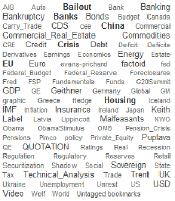




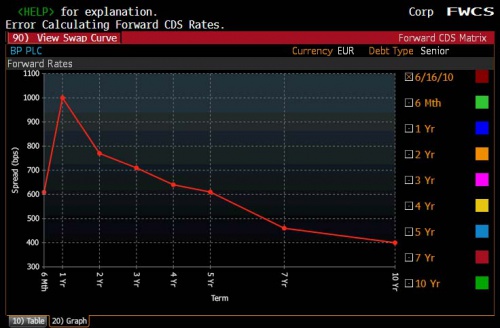


 Assuming $4,000/barrel damages costs, 100,000 barrels per day flow
rates, a 90 day flow duration (minimal), we arrive at clean-up,
litigation and damage compensation of approximately $32B. This is nearly
twice the US escrow account agreement and within our expectations of
between $20 and 60B. There are a range of issues regarding further
leaks, shifting seafloor, methane levels, hurricanes, disbursement
effects and many more that are surfacing daily that will have
significant negative impact on current analysis and assumptions.
Assuming $4,000/barrel damages costs, 100,000 barrels per day flow
rates, a 90 day flow duration (minimal), we arrive at clean-up,
litigation and damage compensation of approximately $32B. This is nearly
twice the US escrow account agreement and within our expectations of
between $20 and 60B. There are a range of issues regarding further
leaks, shifting seafloor, methane levels, hurricanes, disbursement
effects and many more that are surfacing daily that will have
significant negative impact on current analysis and assumptions.


